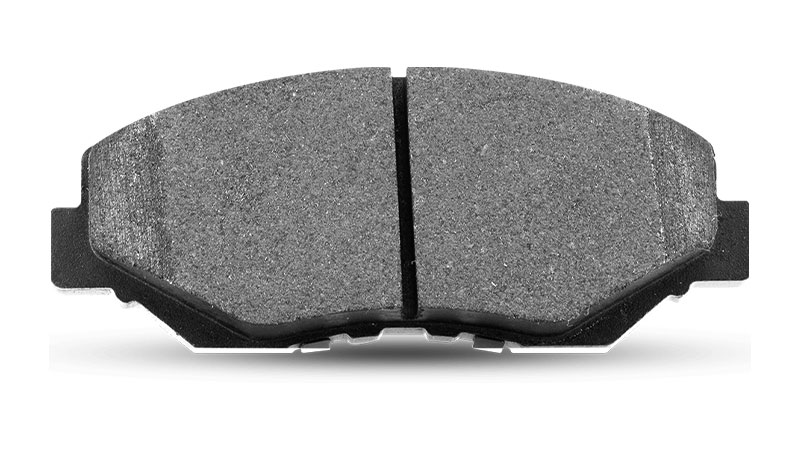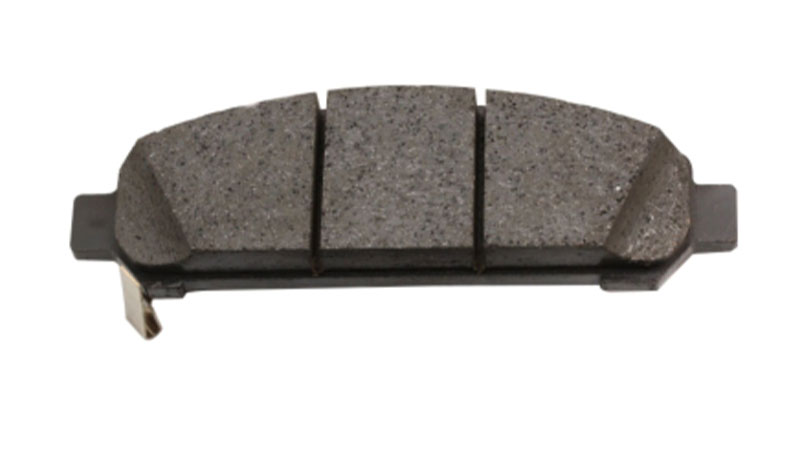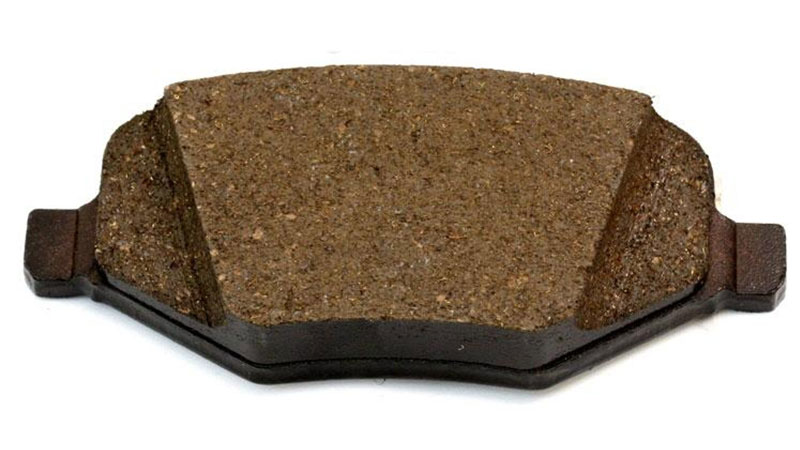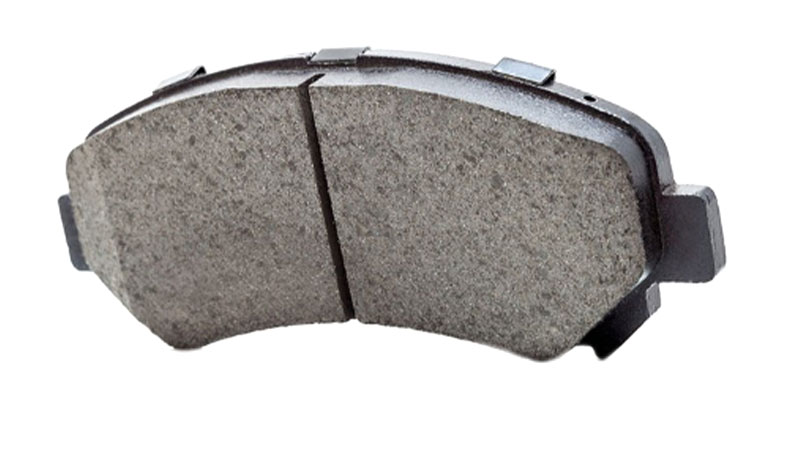Whether you’re slowing for a red light in town or slamming on the brakes for an upcoming hairpin on a racetrack, you need adequate stopping power from your braking system.
The brake pads are the components that do the heavy lifting under braking. Each wheel has its own brake disc, which rotates in time with the wheel. All four brake discs are flanked by two brake pads – one on the outer side and one on the inner side.
When you depress the brake pedal, these pads cling to both sides of the brake disc, using resistance and friction to bring the wheels to a stop. Brake pads can be made of various materials, each proving more effective in certain driving situations.
Identifying which type of brake pad is best for your driving needs is crucial for both performance and safety. This article will explore the four main types of brake pads and their strengths and weaknesses.
Semi-Metallic
Semi-metallic brake pads are one of the more widespread forms of brake pads. They are made by combining metals such as copper and steel with other ingredients like graphite. There are different combinations of materials available.
Some semi-metallic pads contain just 30% metal, while high-performance versions can be made with up to 60 or 70% metal.
These brake pads are adaptable to a wide range of driving and weather conditions, such as wet roads. Semi-metallic brake pads also generate good braking performance on the track or mountain roads, making them a favorite with sports car drivers.
Large vehicles such as trucks also need increased stopping power because of their higher curb weights, making semi-metallic brake pads better suited to these machines than organic brake pads.
Because of their mostly metallic construction, semi-metallic brakes can weather the higher temperatures that are generated by harsh braking. This makes them more resistant to fading and wear compared to weaker organic compounds.
While not as durable as ceramic brakes, semi-metallic brake pads don’t need as much time to heat up to optimum temperature.
With a greater ability to conduct heat more efficiently, semi-metallic brake pads also help the braking system to cool down faster than other types of pads. This helps to prolong the life of the braking system as a whole, especially the brake discs.
Thanks to their more robust design, a driver doesn’t need to press the brake pedal quite as hard if semi-metallic brakes have gotten up to temperature. This further reduces wear, although more pressure will be required if the brakes haven’t quite heated up yet.
However, semi-metallic brakes generate more noise under braking than other types of brake pad materials. Semi-metallic braking systems also cough up more brake dust than ceramic brakes.
That said, semi-metallic brake pads occupy the center of the pricing scale for brake pads, making them affordable for those who need better braking performance.
Non-Asbestos Organic (NAO)
The majority of car manufacturers used to construct brake pads using asbestos. This material was used because it was good at transferring heat away from the brakes.
But with severe health concerns related to asbestos, many worried that the brake dust from these pads contained small particles which could potentially cause cancer and other health issues.
Instead, manufacturers began to utilize organic materials to make standard brake pads. These days, some of the main materials used in non-asbestos organic brakes include cellulose resin, fiberglass, Kevlar, and rubber.
These components can be manufactured cheaply and quickly and have become the standard on many new everyday road cars.
In driving situations that don’t demand aggressive braking, NAO brake pads are more than adequate for most car owners. These brake pads provide good braking performance for everyday driving, benefiting everyone from commuters to town drivers.
NAO brake pads use a softer construction than metallic materials. As a result, NAO brake pads won’t cause as much wear to other braking system components like the brake discs compared to semi-metallic options.
But while they do protect other components from wear, NAO brake pads are more susceptible to wearing down than other brake pad materials. Organic brake pads fade much faster when exposed to too much heat, even the relatively low levels generated by regular road driving.
Despite being cheap on their own, constantly replacing NAO brake pads as they deteriorate isn’t very cost-effective.
The softer and less durable construction of NAO brake pads generates large clouds of brake dust, even when compared to semi-metallic brake pads. Brake dust creates a fine, grimy layer over parts such as the brake discs, reducing the system’s ability to cool down or withstand heat.
Although some of the high-end NAO options that are made from Kevlar can mitigate some of these issues, non-asbestos organic brake pads can be more trouble than they’re worth.
Even for everyday drivers, semi-metallic brakes can be a more efficient long-term option.
Low-Metallic NAO
Low-metallic NAO brake pads combine features of both non-asbestos organic and semi-metallic brake pads. Low-metallic brake pads still use non-asbestos organic materials in their construction but add some metals into the mix as well.
Again, these brake pads remove potentially harmful asbestos from braking systems for a safer option.
Like true non-asbestos organic brake pads, low-metallic NAO options use organic ingredients such as fiberglass and rubber as the main foundation of the pad. Metals such as copper and steel are added in small quantities to the organic materials to create hybrid brake pads.
Between 10% and 30% of a low-metallic brake pad consists of these metals.
This allows low-metallic brake pads to combine some of the advantages of both semi-metallic and non-asbestos organic brake pads. The extra metal content in these brake pads allows them to dissipate larger amounts of heat than purely organic brake pads.
This helps protect the overall braking system from wear, meaning fewer brake disc changes.
Low-metallic brake pads provide more durability than full non-asbestos organic brake pads but aren’t as robust as semi-metallic ones. Low-metallic pads are a good, affordable option for regular commuters or those who do a lot of highway driving.
They provide increased braking performance over NAO pads but can’t rival semi-metallic options for sheer stopping power.
But while low-metallic brake pads do carry some of the advantages of both NAO and semi-metallic options, they share some disadvantages as well. Because they still contain organic materials that deteriorate quickly, low-metallic brake pads can give off high quantities of brake dust.
This can affect other braking components, such as the brake discs.
Like semi-metallic brake pads, low-metallic components can also be quite loud, which can grate on some drivers. However, they can still be a great choice, particularly for regular drivers.
Ceramic
Ceramic brake pads represent the top tier of brake pad technology. As their name implies, these brake pads utilize ceramic materials in their construction, not unlike the ingredients used to make kitchenware.
Unlike the good china, though, ceramic brake pads are durable, heavy-duty pieces of equipment.
Many ceramic brake pads contain extra materials such as copper to boost their ability to transfer heat under heavy braking. With exceptional stopping power and heat resistance, ceramic options represent the best possible performance a driver can get from some brake pads.
Ceramic brake pads are extremely hard-wearing, able to stand up to immense punishment and sky-high operating temperatures.
This extreme performance is perfect for extreme, expensive cars. Ceramic brakes are mainly found on high-end supercars or hypercars. Other brake pad materials simply cannot cope with the sheer friction needed to slow down the wheels of these monstrous machines, especially on a track.
Ceramic brake pads will last longer than any other brake pad material, even when subjected to heavy braking.
This high-end performance continues when it comes to brake noise. Ceramic brake pads are the quietest options available on the market and also hardly produce any brake dust.
This makes them well-suited to more luxurious vehicles – providing fantastic performance without compromising on ride quality.
But this performance does come at a price. A big one. Ceramic brake pads are extremely expensive. For everyday commuters or even those who occasionally drive a sports car, ceramic brake pads simply aren’t worth the huge expense.
Even fun and frisky sports cars simply won’t generate enough heat under braking to get ceramic brake pads into the optimum performance window. While they can withstand much higher braking temperatures, ceramic brakes take some time to warm up fully – longer than any other material.
The vast majority of drivers are still better off with semi-metallic brake pads.
Stopping Is Just As Important As Going
While many drivers are drawn to impressive acceleration or dizzying top speeds, great braking performance is just as important. On the track, being able to trust the brakes helps drivers to extract the best lap time.
For most everyday drivers, having good brakes provides a safe and enjoyable driving experience.
Each type of brake pad discussed above can meet different driving needs. For drivers lucky enough to own a stunning supercar, ceramic brake pads offer the best performance and quality.
If all that’s needed is reliable braking at city speeds, non-asbestos organic or low-metallic brake pads are a cheap and widespread option.
But most drivers will see huge benefits when using semi-metallic brake pads. These versatile components offer the best balance between durability, performance, and value.
From serial commuters to sports car enthusiasts, semi-metallic brake pads are one of the best options available.
Disclosure: As an Amazon Associate, I earn from qualifying purchases made through links on this website.




